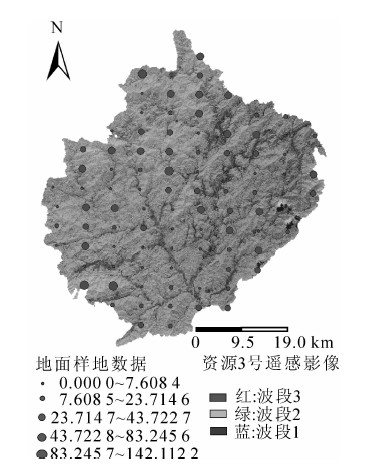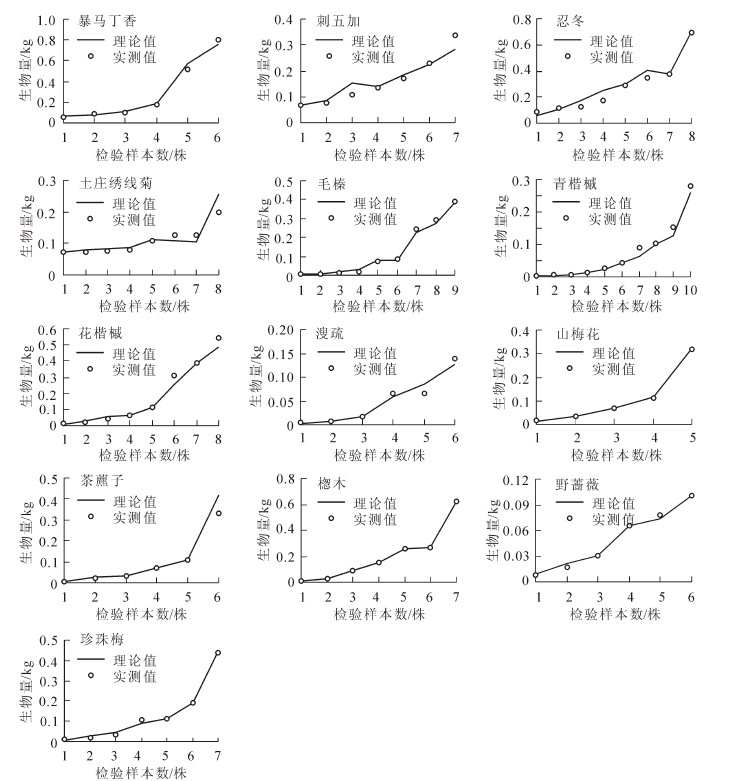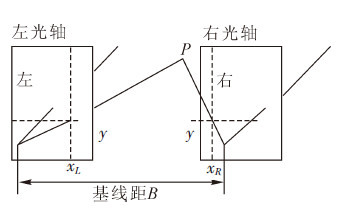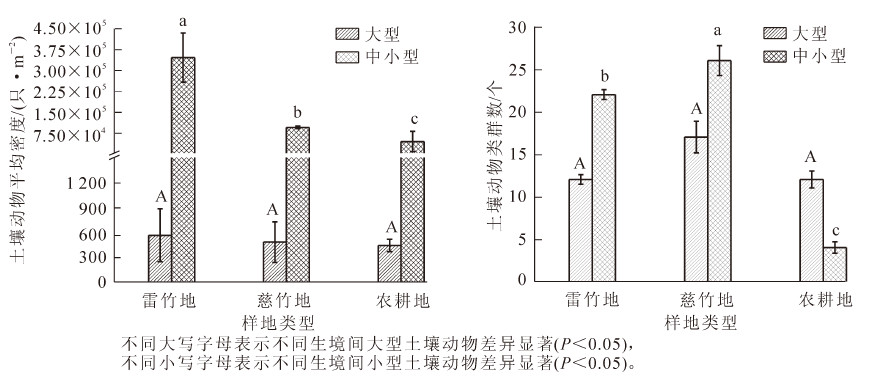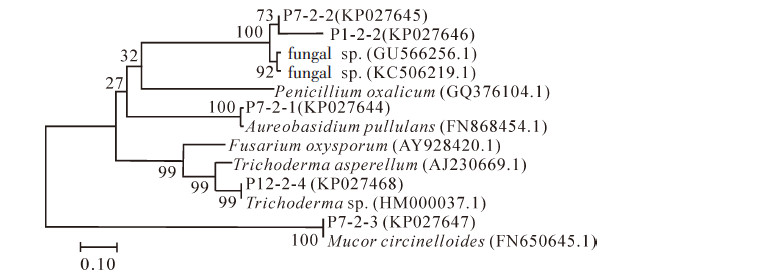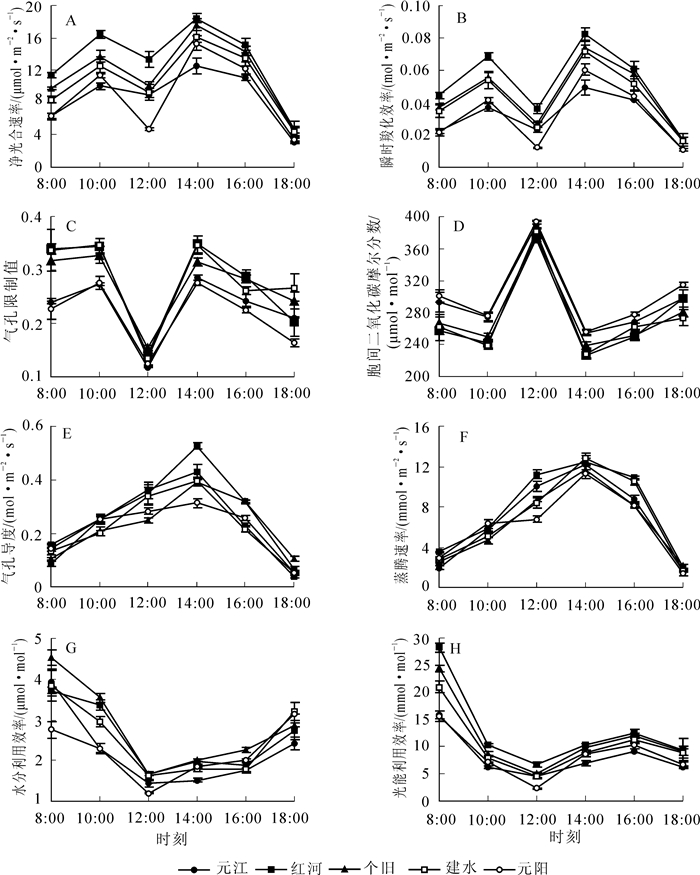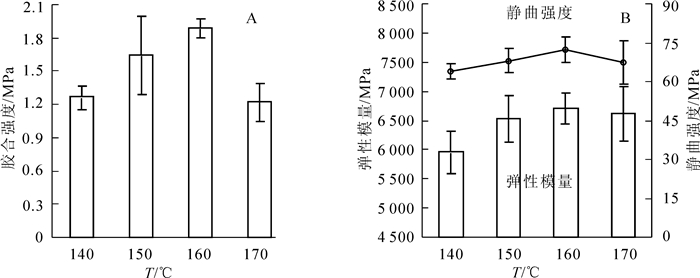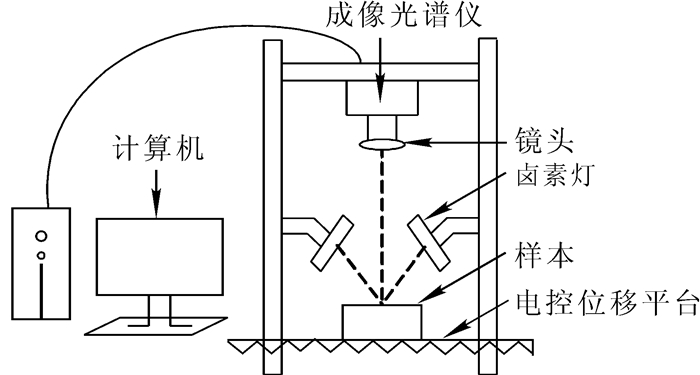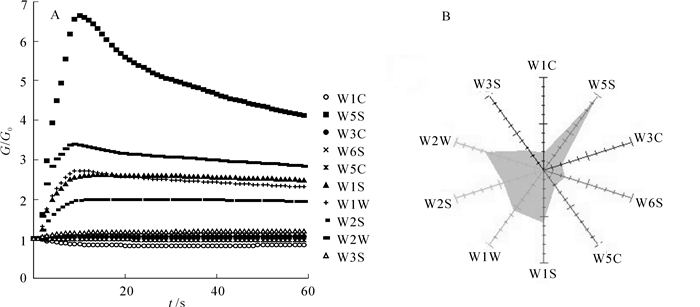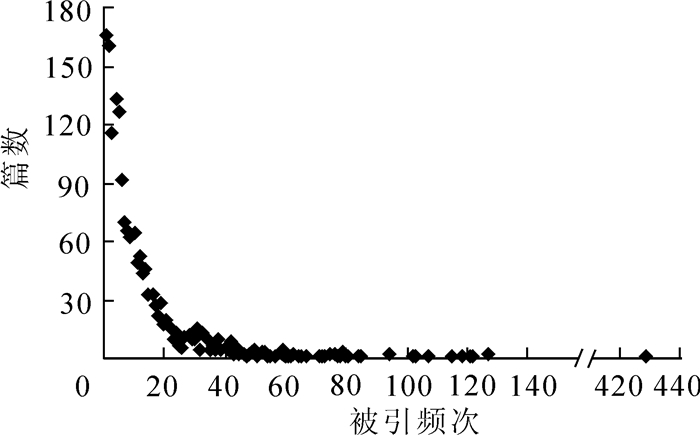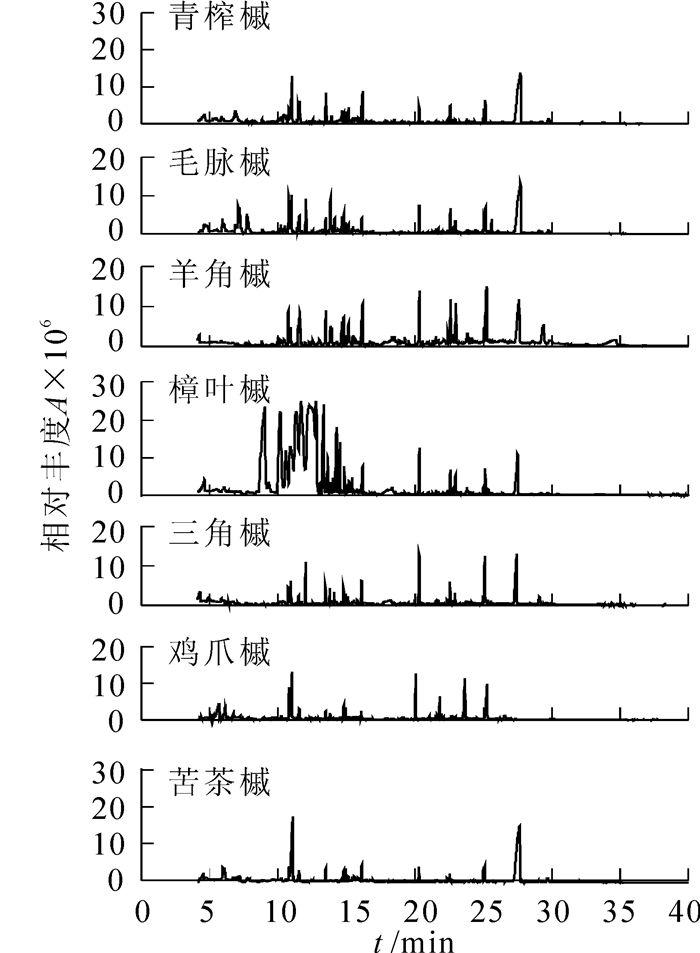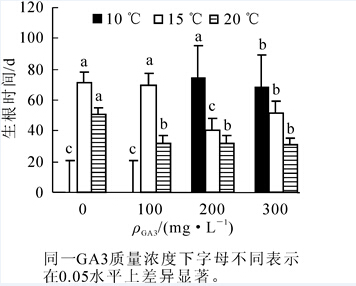2016 Vol. 33, No. 3
2016, 33(3): 369-376.
doi: 10.11833/j.issn.2095-0756.2016.03.001
Abstract:
Based on a data set from 192 farmer households, 16 villages, 4 counties (cities) in Zhejiang collective forest areas, this paper analyzed the status of famers’ forestry production and their technical demand, and examined determinants of farmer’ demand for forestry production techniques using econometrics model. The results shown that: (1) The average forestland size is 1.6 hm2 for each farmer household in collective forest areas, and more than one third of farmer households had ever afforested in the past 5 years; However, the net income from forestry accounted for only 8.2 per cent of the total net income of farmer households. (2) Most farmers acquired the forestry production techniques from their own experience, and only 4.5 per cent of farmer households acquired techniques by trainings; Meanwhile, 40.3 per cent of farmer households need techniques on new species, 31.3 per cent for diseases and pests control. (3)Forest structure, income, training experiences, education were the main determinants of farmer households’ demand for forestry production techniques. Finally, some policy implications were proposed. [Ch, 7 tab. 15 ref.]
Based on a data set from 192 farmer households, 16 villages, 4 counties (cities) in Zhejiang collective forest areas, this paper analyzed the status of famers’ forestry production and their technical demand, and examined determinants of farmer’ demand for forestry production techniques using econometrics model. The results shown that: (1) The average forestland size is 1.6 hm2 for each farmer household in collective forest areas, and more than one third of farmer households had ever afforested in the past 5 years; However, the net income from forestry accounted for only 8.2 per cent of the total net income of farmer households. (2) Most farmers acquired the forestry production techniques from their own experience, and only 4.5 per cent of farmer households acquired techniques by trainings; Meanwhile, 40.3 per cent of farmer households need techniques on new species, 31.3 per cent for diseases and pests control. (3)Forest structure, income, training experiences, education were the main determinants of farmer households’ demand for forestry production techniques. Finally, some policy implications were proposed. [Ch, 7 tab. 15 ref.]
2016, 33(3): 377-383.
doi: 10.11833/j.issn.2095-0756.2016.03.002
Abstract:
Forest carbon storage is almost estimated by the ground survey data, there is a difficulty of huge statistical work and modeling complexity. To calculate forest carbon stocks in a quick and accurate way, which has been the current research focus in forestry both inside and outside of China. A new method is proposed by combining a little input parameters of the InVEST model with a large monitoring scale of remote sensing data. First, InVEST model was used to estimate regional carbon stocks according to forest type carbon data and according to raster data. Then this data was compared to the multistage carbon data from remote sensing data to achieve a dynamic monitoring of forest carbon stocks. This paper estimated and mapped carbon stock of the Qingyuan (a county) in 2009, according to the administrative division map can estimate the carbon storage of the scale of town and village. After estimated carbon reserves of Kengxi (a village) in 2009 and 2014, carbon difference method was adopted to dynamic monitoring of carbon sink. Results showed that the carbon sink estimated with the new method for Qiyuan(a county), Zhejiang, China was 3.274 3×107 Mg in 2009. Also, the carbon stock for Kengxi (a village) increased 1.780 3×104 Mg from 2009 to 2014. Compared to forest average carbon density, adding forest species average carbon storage and carbon sinks to forest carbon stock monitoring improved estimation precision of forest carbon stocks. This dynamic multi-dimensional method for monitoring forest carbon sinks being simple, convenient, user-friendly, and advantageous because it used less data input and visual output in the model, could be used in the county, township (town) and village forest carbon monitoring. [Ch, 5 fig. 4 tab. 32 ref.]
Forest carbon storage is almost estimated by the ground survey data, there is a difficulty of huge statistical work and modeling complexity. To calculate forest carbon stocks in a quick and accurate way, which has been the current research focus in forestry both inside and outside of China. A new method is proposed by combining a little input parameters of the InVEST model with a large monitoring scale of remote sensing data. First, InVEST model was used to estimate regional carbon stocks according to forest type carbon data and according to raster data. Then this data was compared to the multistage carbon data from remote sensing data to achieve a dynamic monitoring of forest carbon stocks. This paper estimated and mapped carbon stock of the Qingyuan (a county) in 2009, according to the administrative division map can estimate the carbon storage of the scale of town and village. After estimated carbon reserves of Kengxi (a village) in 2009 and 2014, carbon difference method was adopted to dynamic monitoring of carbon sink. Results showed that the carbon sink estimated with the new method for Qiyuan(a county), Zhejiang, China was 3.274 3×107 Mg in 2009. Also, the carbon stock for Kengxi (a village) increased 1.780 3×104 Mg from 2009 to 2014. Compared to forest average carbon density, adding forest species average carbon storage and carbon sinks to forest carbon stock monitoring improved estimation precision of forest carbon stocks. This dynamic multi-dimensional method for monitoring forest carbon sinks being simple, convenient, user-friendly, and advantageous because it used less data input and visual output in the model, could be used in the county, township (town) and village forest carbon monitoring. [Ch, 5 fig. 4 tab. 32 ref.]
2016, 33(3): 384-393.
doi: 10.11833/j.issn.2095-0756.2016.03.003
Abstract:
To estimate the spatial distribution of aboveground forest carbon storage, an important index of forest ecosystem productivity and the foundation of regional forest carbon sink measurements, and carbon density in Kaihua County, Zhejiang Province, ZY-3 image data from 2013, National Forest Inventory data from 2014, and the Sequential Gaussian Co-simulation Method were used. Estimated results of above ground forest carbon were analyzed by four indicators: mean error (ME), residual square sum (RSS), mean relative error (MRE), and root mean square error (RMSE). A correlation analysis between sample plots of remote sensing and forest carbon density was also conducted. Results showed that the above ground carbon was 7.221 573 Tg, estimated values of spatial co-simulation ranged from 0 to 109.178 Mg·hm-2, mean carbon density was 32.376 4 Mg·hm-2, mean relative error based on the 15% test sample was 4.565%, and forest carbon estimated by simulation was in the confidence interval range measured by sample plots. Also, the correlation analysis varied with the resolution of remote sensing image changes. Thus, a key point of further research would be to improve the estimation accuracy of forest carbon reserves.[Ch, 5 fig. 3 tab. 29 ref.]
To estimate the spatial distribution of aboveground forest carbon storage, an important index of forest ecosystem productivity and the foundation of regional forest carbon sink measurements, and carbon density in Kaihua County, Zhejiang Province, ZY-3 image data from 2013, National Forest Inventory data from 2014, and the Sequential Gaussian Co-simulation Method were used. Estimated results of above ground forest carbon were analyzed by four indicators: mean error (ME), residual square sum (RSS), mean relative error (MRE), and root mean square error (RMSE). A correlation analysis between sample plots of remote sensing and forest carbon density was also conducted. Results showed that the above ground carbon was 7.221 573 Tg, estimated values of spatial co-simulation ranged from 0 to 109.178 Mg·hm-2, mean carbon density was 32.376 4 Mg·hm-2, mean relative error based on the 15% test sample was 4.565%, and forest carbon estimated by simulation was in the confidence interval range measured by sample plots. Also, the correlation analysis varied with the resolution of remote sensing image changes. Thus, a key point of further research would be to improve the estimation accuracy of forest carbon reserves.[Ch, 5 fig. 3 tab. 29 ref.]
2016, 33(3): 394-402.
doi: 10.11833/j.issn.2095-0756.2016.03.004
Abstract:
In order to study the shrub biomass in the forest in Jingouling Plantation and there wasn’t a comprehensive shrub models study in this area. Three different forest densities (0.6, 0.8, 1.0) of a natural spruce-fir Picea koraiensis-Picea jezoensis-Abies nephrolepis forest in Jingouling Plantation, Jilin Province were used for this research. Based on measured data for shrub biomass under the forest canopy, 13 mixed biomass models for 13 different species and biomass models of the different shrubs’ organs were respectively constructed by R software. Then the optimal model was selected using the largest R2 and F and the smallest ESEE and E. Also differences in shrub biomass for forests of different densities and for different species distribution with the same forest density were studied. Shrub quadrat 5 m × 5 m were setted in the center and four corner at each sample plot (20 m × 20 m), then measured the diameter D, crown width C1, C2, and height H. According to the results of the shrub species, 13 species, were selected from the sample plots. Results showed that the optimal biomass model (R2=0.626 2-0.997 9)for different organs in each species as well as for leaves and roots of Acer tegmentosum, and the trunk of Acer ukurunduense was a power function; whereas the optimal model of the other species was a quadratic equation or binary linear equation. The independent variable of the model for stem and branch biomass was AC(AC=πC1C2/4) with the other species being D2H and CH(crown width multiply height). The independent variables in the optimal model of leaf biomass for species Spiraea pubescens, Acanthopanax senticosus and A. tegmentosum used factors of AC and CH, but other species used variables D and D2H. The optimal model for root biomass was D2H. The accuracy of the models are relatively high, and they meets the requirements of biomass model estimation, which provides the basis for the measurement of shrub biomass in this region. The research is only suitable for this area and the shrubs’ ground diameter must in a certain range, for other areas to be further studied[Ch, 2 fig. 4 tab. 27 ref.]
In order to study the shrub biomass in the forest in Jingouling Plantation and there wasn’t a comprehensive shrub models study in this area. Three different forest densities (0.6, 0.8, 1.0) of a natural spruce-fir Picea koraiensis-Picea jezoensis-Abies nephrolepis forest in Jingouling Plantation, Jilin Province were used for this research. Based on measured data for shrub biomass under the forest canopy, 13 mixed biomass models for 13 different species and biomass models of the different shrubs’ organs were respectively constructed by R software. Then the optimal model was selected using the largest R2 and F and the smallest ESEE and E. Also differences in shrub biomass for forests of different densities and for different species distribution with the same forest density were studied. Shrub quadrat 5 m × 5 m were setted in the center and four corner at each sample plot (20 m × 20 m), then measured the diameter D, crown width C1, C2, and height H. According to the results of the shrub species, 13 species, were selected from the sample plots. Results showed that the optimal biomass model (R2=0.626 2-0.997 9)for different organs in each species as well as for leaves and roots of Acer tegmentosum, and the trunk of Acer ukurunduense was a power function; whereas the optimal model of the other species was a quadratic equation or binary linear equation. The independent variable of the model for stem and branch biomass was AC(AC=πC1C2/4) with the other species being D2H and CH(crown width multiply height). The independent variables in the optimal model of leaf biomass for species Spiraea pubescens, Acanthopanax senticosus and A. tegmentosum used factors of AC and CH, but other species used variables D and D2H. The optimal model for root biomass was D2H. The accuracy of the models are relatively high, and they meets the requirements of biomass model estimation, which provides the basis for the measurement of shrub biomass in this region. The research is only suitable for this area and the shrubs’ ground diameter must in a certain range, for other areas to be further studied[Ch, 2 fig. 4 tab. 27 ref.]
2016, 33(3): 403-408.
doi: 10.11833/j.issn.2095-0756.2016.03.005
Abstract:
The research aims to improve the accuracy of tree growth status measurement, overcome the deficiencies in the traditional measuring methods. From the perspective of disparity processing, based on the tree image information collected at different time points, and through the method of feature point extraction, the changes of tree growth status within a period of time were examined. In the experiment, red rectangular information points were marked on the tree and two cameras were used to capture feature points, then the collected color information of two images was extracted and compared to calculate the space change of calibration points in a certain time interval. And the experimental results showed that the traditional method measuring height and thickness did not conform to the actual growth status of the trees. But height and thickness measuring based on vision technology was in line with the actual growth process of trees. The visual measuring method is able to conduct nondestructive measurement of tree growth, and judge the change of growth status of trees.[Ch, 4 fig. 1 tab. 22 ref.]
The research aims to improve the accuracy of tree growth status measurement, overcome the deficiencies in the traditional measuring methods. From the perspective of disparity processing, based on the tree image information collected at different time points, and through the method of feature point extraction, the changes of tree growth status within a period of time were examined. In the experiment, red rectangular information points were marked on the tree and two cameras were used to capture feature points, then the collected color information of two images was extracted and compared to calculate the space change of calibration points in a certain time interval. And the experimental results showed that the traditional method measuring height and thickness did not conform to the actual growth status of the trees. But height and thickness measuring based on vision technology was in line with the actual growth process of trees. The visual measuring method is able to conduct nondestructive measurement of tree growth, and judge the change of growth status of trees.[Ch, 4 fig. 1 tab. 22 ref.]
2016, 33(3): 409-417.
doi: 10.11833/j.issn.2095-0756.2016.03.006
Abstract:
Phyllostachys violascens, an economic plant, was introduced into Dujiangyan from Zhejiang Province after earthquake, not only can increase local people’s incomes, but also plays an important role in ecology construction. Soil fauna, an important component of soil ecosystems, the density, groups and diversity were easily affected by the plant types. To determine the effects of Phyllostachys violascens cultivation on soil fauna community structure, a study was carried out in fields of Ph. violascens, Neosinocalamus affinis, and cropland in October 2014. Macrofauna samples (n=3) were picked up by hand with the area of 50 cm × 50 cm(0.25 m2). After recording the types of soil fauna, the samples were put into a container with alcohol and transported to laboratory for detailed classification to family level. Mesofauna was collected by steel core (r = 5 cm, v =100 cm3) and store in soil fauna sealing black bags. The collected samples then were transported to laboratory within 12 h and subsequently separated by Baermann method (for nematodes) and Tullgren method (for mesofauna) over a period of 48 h, respectively. All collected soil fauna were calculated and classified by microscope, and identified to the family level following Pictorial Keys to Soil Animals of China. Indexes used in the analysis included: average density, group number, density-groups, Margalef, Shannon-Wiener, Pieluo, Simpson and Sorensen. A total of 3 477 soil fauna individuals, belonging to 3 phyla, 9 classes, and 24 orders were collected. Significant differences were found among the three plots (F test, P < 0.05): with the average density for soil fauna being Ph. violascens (3.47 ×105 ind·m-2) > N. affinis (9.65 ×104 ind·m-2) > cropland (4.58 ×104 ind·m-2) and with the order for group number being N. affinis (30) > Ph. violascens (28) > cropland (15). The density-groups index for Ph. violascens was significantly higher (F test, P < 0.05) than that in the other two plots; significant differences for the Margalef index value were found in multiple comparison of three plots (F test, P < 0.05); and no significant differences were found among the three plots for Pieluo and Simpson index . For vertical distribution in the three plots, soil fauna density decreased with increasing depth. The largest similarity index was found between the Ph. violascens and N. affinis, with a decrease as depth increased. After comparing the soil fauna characteristics with N. affinis and cropland, respectively, introducing Ph. violascens cultivation had a positive effect on the distribution and diversity of soil fauna. [Ch, 2 fig. 5 tab. 32 ref.]
Phyllostachys violascens, an economic plant, was introduced into Dujiangyan from Zhejiang Province after earthquake, not only can increase local people’s incomes, but also plays an important role in ecology construction. Soil fauna, an important component of soil ecosystems, the density, groups and diversity were easily affected by the plant types. To determine the effects of Phyllostachys violascens cultivation on soil fauna community structure, a study was carried out in fields of Ph. violascens, Neosinocalamus affinis, and cropland in October 2014. Macrofauna samples (n=3) were picked up by hand with the area of 50 cm × 50 cm(0.25 m2). After recording the types of soil fauna, the samples were put into a container with alcohol and transported to laboratory for detailed classification to family level. Mesofauna was collected by steel core (r = 5 cm, v =100 cm3) and store in soil fauna sealing black bags. The collected samples then were transported to laboratory within 12 h and subsequently separated by Baermann method (for nematodes) and Tullgren method (for mesofauna) over a period of 48 h, respectively. All collected soil fauna were calculated and classified by microscope, and identified to the family level following Pictorial Keys to Soil Animals of China. Indexes used in the analysis included: average density, group number, density-groups, Margalef, Shannon-Wiener, Pieluo, Simpson and Sorensen. A total of 3 477 soil fauna individuals, belonging to 3 phyla, 9 classes, and 24 orders were collected. Significant differences were found among the three plots (F test, P < 0.05): with the average density for soil fauna being Ph. violascens (3.47 ×105 ind·m-2) > N. affinis (9.65 ×104 ind·m-2) > cropland (4.58 ×104 ind·m-2) and with the order for group number being N. affinis (30) > Ph. violascens (28) > cropland (15). The density-groups index for Ph. violascens was significantly higher (F test, P < 0.05) than that in the other two plots; significant differences for the Margalef index value were found in multiple comparison of three plots (F test, P < 0.05); and no significant differences were found among the three plots for Pieluo and Simpson index . For vertical distribution in the three plots, soil fauna density decreased with increasing depth. The largest similarity index was found between the Ph. violascens and N. affinis, with a decrease as depth increased. After comparing the soil fauna characteristics with N. affinis and cropland, respectively, introducing Ph. violascens cultivation had a positive effect on the distribution and diversity of soil fauna. [Ch, 2 fig. 5 tab. 32 ref.]
2016, 33(3): 418-426.
doi: 10.11833/j.issn.2095-0756.2016.03.007
Abstract:
This study aimed to screen high efficiency decolorizing fungi for degradation of structurally different synthetic dyes. Fungal strains were isolated and screened from soil of bamboo plantation (Phyllostachys violascens) using conventional separation, cultivation methods, and sequence alignment analysis of nuclear ribosomal internal transcribed spacers (ITS). The bamboo plantation for isolating soil fungi consisted of bamboo forests aged 1, 7, 12, and 15 years, which applied no heavy fertilization and organic mulch until year 5. Result showed that Trichoderma sp. had the highest isolation frequency in the cultured fungi from topsoil based on morphological identification and phylogenetic analysis. Decolorization capacity of the five isolated fungi ((P7-2-1, P7-2-2, P1-2-2, P7-2-3, P12-2-4) to the five different synthetic dyes (Congo red, orange G, crystal violet, fuchsin acid, and methyl orange) showed that P7-2-3 (identified as Mucor circinelloides) and P12-2-4 (identified as Trichoderma spp.) had the strongest capacity to decolorize the five kinds of dyes. The decolorization efficiency of P7-2-3 and P12-2-4 to crystal violet was similar at different crystal violet concentrations below 500.0 mg·L-1; however, crystal violet inhibited the decolonization reaction at concentrations of 300.0 mg·L-1 for strain P7-2-3 and 400.0 mg·L-1 for strain P12-2-4. The fungal biomass and dye decolorization had a positive relationship for different concentrations of crystal violet, and strains of P7-2-3 and P12-2-4 have potential value for application in decolorization and degradation of dyes wastewater. [Ch, 4 fig. 2 tab. 31 ref.]
This study aimed to screen high efficiency decolorizing fungi for degradation of structurally different synthetic dyes. Fungal strains were isolated and screened from soil of bamboo plantation (Phyllostachys violascens) using conventional separation, cultivation methods, and sequence alignment analysis of nuclear ribosomal internal transcribed spacers (ITS). The bamboo plantation for isolating soil fungi consisted of bamboo forests aged 1, 7, 12, and 15 years, which applied no heavy fertilization and organic mulch until year 5. Result showed that Trichoderma sp. had the highest isolation frequency in the cultured fungi from topsoil based on morphological identification and phylogenetic analysis. Decolorization capacity of the five isolated fungi ((P7-2-1, P7-2-2, P1-2-2, P7-2-3, P12-2-4) to the five different synthetic dyes (Congo red, orange G, crystal violet, fuchsin acid, and methyl orange) showed that P7-2-3 (identified as Mucor circinelloides) and P12-2-4 (identified as Trichoderma spp.) had the strongest capacity to decolorize the five kinds of dyes. The decolorization efficiency of P7-2-3 and P12-2-4 to crystal violet was similar at different crystal violet concentrations below 500.0 mg·L-1; however, crystal violet inhibited the decolonization reaction at concentrations of 300.0 mg·L-1 for strain P7-2-3 and 400.0 mg·L-1 for strain P12-2-4. The fungal biomass and dye decolorization had a positive relationship for different concentrations of crystal violet, and strains of P7-2-3 and P12-2-4 have potential value for application in decolorization and degradation of dyes wastewater. [Ch, 4 fig. 2 tab. 31 ref.]
2016, 33(3): 427-433.
doi: 10.11833/j.issn.2095-0756.2016.03.008
Abstract:
To assess pollution characteristics and the degree of heavy metal pollution and to discuss their probable sources, the topsoil of Yongkang City was divided into seven zones based on a survey of the region. Altogether 203 urban soil samples were collected, and ten kinds of heavy metal elements were analyzed. Then a single factor evaluation and the Nemerow integrated pollution index for different functional zones were employed to investigate pollution characteristics of heavy metals. Also a multivariate statistical analysis was used to analyze sample dates. Results showed that mean concentrations for heavy metals (in mg·kg-1) were As (6.57), Co(10.57), Cr(119.55), Cu(22.97), Mn(528.51), Ni 22.45), Pb(37.67), Ti(5 751.81), V(84.37), and Zn(90.25). The single factor integrated pollution index for order of different heavy metals was Cr > Ni > V > Co > Ti > Cu > Zn > Mn > Pb > As, and the Nemerow integrated pollution index order was industrial zone > traffic zone > parkland zone > residential zone > woodland zone > municipal zone > cultivated land. Results of the principal component analysis indicated that Cr, Cu, Ni, Pb, and Zn were mainly from hardware manufacturing industry and local transportation; As and V came from industrial and natural soil forming processes; and Co and Ti mainly originated from hardware manufacturing industry.[Ch, 2 fig. 8 tab. 22 ref.]
To assess pollution characteristics and the degree of heavy metal pollution and to discuss their probable sources, the topsoil of Yongkang City was divided into seven zones based on a survey of the region. Altogether 203 urban soil samples were collected, and ten kinds of heavy metal elements were analyzed. Then a single factor evaluation and the Nemerow integrated pollution index for different functional zones were employed to investigate pollution characteristics of heavy metals. Also a multivariate statistical analysis was used to analyze sample dates. Results showed that mean concentrations for heavy metals (in mg·kg-1) were As (6.57), Co(10.57), Cr(119.55), Cu(22.97), Mn(528.51), Ni 22.45), Pb(37.67), Ti(5 751.81), V(84.37), and Zn(90.25). The single factor integrated pollution index for order of different heavy metals was Cr > Ni > V > Co > Ti > Cu > Zn > Mn > Pb > As, and the Nemerow integrated pollution index order was industrial zone > traffic zone > parkland zone > residential zone > woodland zone > municipal zone > cultivated land. Results of the principal component analysis indicated that Cr, Cu, Ni, Pb, and Zn were mainly from hardware manufacturing industry and local transportation; As and V came from industrial and natural soil forming processes; and Co and Ti mainly originated from hardware manufacturing industry.[Ch, 2 fig. 8 tab. 22 ref.]
2016, 33(3): 434-439.
doi: 10.11833/j.issn.2095-0756.2016.03.009
Abstract:
Polybrominated diphenyl ethers (PBDEs), widely used as fire retardants, can migrate to the surrounding environment. To prevent damage to human organs, nervous system, and immune system a method was devised to remove this dangerous pollutant from the environment. In this research, microspheres were successfully made by mixing different concentrations of sodium alginate and biochar to degrade PBDEs. Then using 4-bromine biphenyl ether (BDE-3) as a homologous compound of PBDEs, the microspheres' potential for adsorption of BDE-3 was studied. The degradation effect was also explored with a newly produced microsphere-microbe complex, which was made by adding a degrading strain of Sphingomonas sp. DZ3. Results showed that 2% sodium alginate was the optimum prepared concentration. The microsphere adsorption process for BDE-3 in liquid was in accord with the Lagergren pseudo-first-order kinetic model and Elovich equation. The maximum biosorption capacity was 28.6 mg·g-1. Also, compared to free microbes, in BDE-3-polluted water the microsphere-microbe complex significantly increased the BDE-3 removal rate (P<0.01 by SPSS analysis). Degradation data from the microsphere-microbe complex were fitted with the Monod Model yielding the degradation dynamics equation of ν= νmax·S/(Ks + S)= 14.29·S/(31.71 + S). The results provide a theoretical basis for the actual development and utilization of microsphere agent in treatment of PBDEs-polluted water
Polybrominated diphenyl ethers (PBDEs), widely used as fire retardants, can migrate to the surrounding environment. To prevent damage to human organs, nervous system, and immune system a method was devised to remove this dangerous pollutant from the environment. In this research, microspheres were successfully made by mixing different concentrations of sodium alginate and biochar to degrade PBDEs. Then using 4-bromine biphenyl ether (BDE-3) as a homologous compound of PBDEs, the microspheres' potential for adsorption of BDE-3 was studied. The degradation effect was also explored with a newly produced microsphere-microbe complex, which was made by adding a degrading strain of Sphingomonas sp. DZ3. Results showed that 2% sodium alginate was the optimum prepared concentration. The microsphere adsorption process for BDE-3 in liquid was in accord with the Lagergren pseudo-first-order kinetic model and Elovich equation. The maximum biosorption capacity was 28.6 mg·g-1. Also, compared to free microbes, in BDE-3-polluted water the microsphere-microbe complex significantly increased the BDE-3 removal rate (P<0.01 by SPSS analysis). Degradation data from the microsphere-microbe complex were fitted with the Monod Model yielding the degradation dynamics equation of ν= νmax·S/(Ks + S)= 14.29·S/(31.71 + S). The results provide a theoretical basis for the actual development and utilization of microsphere agent in treatment of PBDEs-polluted water
2016, 33(3): 440-448.
doi: 10.11833/j.issn.2095-0756.2016.03.010
Abstract:
To understand the photosynthetic and physiological characteristics of the seedling stage for different provenances of Calotropis gigantea in a hot-dry valley area, changes in daily mean values for net photosynthetic rate (Pn), stomatal conductance (Gs), intercellular CO2 concentration (Ci), transpiration rate (Tr), water use efficiency (WUE), light use efficiency (LUE), carboxylation efficiency (CE), and stomatal limitation (ls) of C. gigantea seedlings from Yuanjiang, Honghe, Gejiu, Jianshui, and Yuanyang provenances were compared and analyzed using multiple comparison analysis of Duncan’s test. Results of diurnal dynamics for the net photosynthetic rates from all provenances showed bimodal curves, but there were different times associated with the values. C. gigantea has strong adaptability to high temperature, which can improve the photosynthetic assimilation efficiency by increasing the stomatal conductance and transpiration. The extreme high temperature in hot-dry valleys is not the limiting factor to influence photosynthesis and carboxylation reaction of C. gigantea seedlings, however, the high light radiation at midday significantly inhibits their photosynthesis and water utilization. The daily mean values for photosynthetic and physiological parameters showed that Honghe provenance had a significantly higher (P < 0.05) net photosynthetic rate, transpiration rate, light use efficiency, and carboxylation efficiency than the other four provenances. Also, Gejiu provenance had a highest (P < 0.05) water use efficiency and a high-level net photosynthetic rate, light use efficiency, and carboxylation efficiency. Consequently, Honghe and Gejiu provenances are considered superior for planting in hot-dry valleys having high-level photosynthetic production and water utilization potential.[Ch, 3 fig. 1 tab. 43 ref.]
To understand the photosynthetic and physiological characteristics of the seedling stage for different provenances of Calotropis gigantea in a hot-dry valley area, changes in daily mean values for net photosynthetic rate (Pn), stomatal conductance (Gs), intercellular CO2 concentration (Ci), transpiration rate (Tr), water use efficiency (WUE), light use efficiency (LUE), carboxylation efficiency (CE), and stomatal limitation (ls) of C. gigantea seedlings from Yuanjiang, Honghe, Gejiu, Jianshui, and Yuanyang provenances were compared and analyzed using multiple comparison analysis of Duncan’s test. Results of diurnal dynamics for the net photosynthetic rates from all provenances showed bimodal curves, but there were different times associated with the values. C. gigantea has strong adaptability to high temperature, which can improve the photosynthetic assimilation efficiency by increasing the stomatal conductance and transpiration. The extreme high temperature in hot-dry valleys is not the limiting factor to influence photosynthesis and carboxylation reaction of C. gigantea seedlings, however, the high light radiation at midday significantly inhibits their photosynthesis and water utilization. The daily mean values for photosynthetic and physiological parameters showed that Honghe provenance had a significantly higher (P < 0.05) net photosynthetic rate, transpiration rate, light use efficiency, and carboxylation efficiency than the other four provenances. Also, Gejiu provenance had a highest (P < 0.05) water use efficiency and a high-level net photosynthetic rate, light use efficiency, and carboxylation efficiency. Consequently, Honghe and Gejiu provenances are considered superior for planting in hot-dry valleys having high-level photosynthetic production and water utilization potential.[Ch, 3 fig. 1 tab. 43 ref.]
2016, 33(3): 449-454.
doi: 10.11833/j.issn.2095-0756.2016.03.011
Abstract:
To study the relief of salicylic acid (SA) on thermal damage in chrysanthemum seedlings with high temperature stresses of 0, 24, 48, and 72 h, cuttings from 40-day-old summer chrysanthemum seedlings were used as materials. Leaves were sprayed with different concentrations of SA (0, 15, 30, 45, and 60 mmol·L-1). Then the content of chlorophyll, malondialdehyde (MDA), proline, free soluble sugar, and free soluble protein, were studied along with activities of superoxide dismutase (SOD), peroxidase (POD), and hydrogen peroxide (CAT) enzyme. Results showed that compared with the controls, the 30 mmol·L-1 salicylic acid treatment on the leaf for 72 h reduced leaf chlorophyll content 1.7%, have significant difference (P < 0.05). After high temperature treatment, best results were with the 30 mmol·L-1 salicylic acid treatment where compared to the control the MDA content increased 86.8%, have significant difference(P < 0.05). The content of proline (94.3%), free soluble sugar (112.1%), and free soluble protein (80%) significantly increased than other treatments (P < 0.05). SOD activity first increased, then decreased, whereas POD and catalase (CAT) activity increased. The 30 mmol·L-1 SA concentration had the greatest effect on SOD and POD, and 15 mmol·L-1 SA had the greatest effect on CAT. Thus, a short duration of high temperature stress damaged chrysanthemum leaves, but SA could play a protective role mitigating the damage. [Ch, 4 fig. 14 ref.]
To study the relief of salicylic acid (SA) on thermal damage in chrysanthemum seedlings with high temperature stresses of 0, 24, 48, and 72 h, cuttings from 40-day-old summer chrysanthemum seedlings were used as materials. Leaves were sprayed with different concentrations of SA (0, 15, 30, 45, and 60 mmol·L-1). Then the content of chlorophyll, malondialdehyde (MDA), proline, free soluble sugar, and free soluble protein, were studied along with activities of superoxide dismutase (SOD), peroxidase (POD), and hydrogen peroxide (CAT) enzyme. Results showed that compared with the controls, the 30 mmol·L-1 salicylic acid treatment on the leaf for 72 h reduced leaf chlorophyll content 1.7%, have significant difference (P < 0.05). After high temperature treatment, best results were with the 30 mmol·L-1 salicylic acid treatment where compared to the control the MDA content increased 86.8%, have significant difference(P < 0.05). The content of proline (94.3%), free soluble sugar (112.1%), and free soluble protein (80%) significantly increased than other treatments (P < 0.05). SOD activity first increased, then decreased, whereas POD and catalase (CAT) activity increased. The 30 mmol·L-1 SA concentration had the greatest effect on SOD and POD, and 15 mmol·L-1 SA had the greatest effect on CAT. Thus, a short duration of high temperature stress damaged chrysanthemum leaves, but SA could play a protective role mitigating the damage. [Ch, 4 fig. 14 ref.]
2016, 33(3): 455-461.
doi: 10.11833/j.issn.2095-0756.2016.03.012
Abstract:
Branches and leaf buds of four Liriodendron chinense provenances were collected both in autumn and winter to measure cold-resistant physiological indicators. Subordinate function analysis was used to evaluate the cold resistance of Liriodendron chinense provenances comprehensively. Cold-resistant physiological indicators of different provenances showed obvious seasonal variation, and had the same trend in the four provenances. Specifically, MDA content, soluble protein content, SOD activity, soluble sugar content, proline content of leaf bud in winter were higher than those in autumn; relative electric conductivity and water content in winter were lower than those in autumn. According to the measurement data of physiological indicators, subordinate function values of four provenances were calculated as the comprehensive evaluation values of cold resistance. The cold-resistant ability of four provenances was sorted as: Dabie shan(0.834) > Fuyang(0.488) > Liping(0.286) > Mengla(0.021). Correlation analysis showed that relative electric conductivity and water content had significantly negative correlation with the subordinate function value, while proline content had significant positive correlation with the subordinate function value. Therefore, these indicators can be used as suitable evaluation indicators. [Ch, 6 tab. 24 ref.]
Branches and leaf buds of four Liriodendron chinense provenances were collected both in autumn and winter to measure cold-resistant physiological indicators. Subordinate function analysis was used to evaluate the cold resistance of Liriodendron chinense provenances comprehensively. Cold-resistant physiological indicators of different provenances showed obvious seasonal variation, and had the same trend in the four provenances. Specifically, MDA content, soluble protein content, SOD activity, soluble sugar content, proline content of leaf bud in winter were higher than those in autumn; relative electric conductivity and water content in winter were lower than those in autumn. According to the measurement data of physiological indicators, subordinate function values of four provenances were calculated as the comprehensive evaluation values of cold resistance. The cold-resistant ability of four provenances was sorted as: Dabie shan(0.834) > Fuyang(0.488) > Liping(0.286) > Mengla(0.021). Correlation analysis showed that relative electric conductivity and water content had significantly negative correlation with the subordinate function value, while proline content had significant positive correlation with the subordinate function value. Therefore, these indicators can be used as suitable evaluation indicators. [Ch, 6 tab. 24 ref.]
2016, 33(3): 462-470.
doi: 10.11833/j.issn.2095-0756.2016.03.013
Abstract:
To understand the effects of mechanical damage on the antioxidant defense system of Artemisia frigida, we analyzed the changes of reactive oxygen species (ROS) level, antioxidant enzyme activities, and ascorbate-glutathione (AsA-GSH) cycle efficiency under light, moderate, and heavy mechanical damage. Results showed that with a mechanical damage treatment, the O·2- production rate, H2O2, and malondialdehyde (MDA) contentincreased significantly (P≤0.05) in leaves and roots of A. frigida and was significantly lower (P≤0.05) in roots than in leaves. Also, activities of superoxide dismutase (SOD), catalase (CAT), and peroxidase (POD) were significantly higher (P≤0.05) with the mechanical damage treatment compared to the control. The activities of ascorbate peroxidase (APX), monodehydroascorbate reductase (MDHAR), dehydroascorbate reductase (DHAR), and glutathione reductase (GR), as well as regenerating rates of AsA and GSH, and redox statuses (ratios of AsA/DHA and GSH/GSSG) with light and moderate mechanical damage were not significantly different (P≥0.05) from the control; whereas compared to the control efficiency of the AsA-GSH cycle was significantly lower (P≤0.05) with heavy mechanical damage. The antioxidant defense system in roots of A. frigida also showed obvious stress in response to mechanical damage capacities. It was concluded that with light and moderate mechanical damage A. frigida had an efficient metabolism in the ascorbate-glutathione cycle, which rapidly scavenged H2O2 to alleviate the oxidative damage and, therefore, had a stronger tolerance to mechanical stress damage. [Ch, 4 fig. 1 tab. 42 ref.]
To understand the effects of mechanical damage on the antioxidant defense system of Artemisia frigida, we analyzed the changes of reactive oxygen species (ROS) level, antioxidant enzyme activities, and ascorbate-glutathione (AsA-GSH) cycle efficiency under light, moderate, and heavy mechanical damage. Results showed that with a mechanical damage treatment, the O·2- production rate, H2O2, and malondialdehyde (MDA) contentincreased significantly (P≤0.05) in leaves and roots of A. frigida and was significantly lower (P≤0.05) in roots than in leaves. Also, activities of superoxide dismutase (SOD), catalase (CAT), and peroxidase (POD) were significantly higher (P≤0.05) with the mechanical damage treatment compared to the control. The activities of ascorbate peroxidase (APX), monodehydroascorbate reductase (MDHAR), dehydroascorbate reductase (DHAR), and glutathione reductase (GR), as well as regenerating rates of AsA and GSH, and redox statuses (ratios of AsA/DHA and GSH/GSSG) with light and moderate mechanical damage were not significantly different (P≥0.05) from the control; whereas compared to the control efficiency of the AsA-GSH cycle was significantly lower (P≤0.05) with heavy mechanical damage. The antioxidant defense system in roots of A. frigida also showed obvious stress in response to mechanical damage capacities. It was concluded that with light and moderate mechanical damage A. frigida had an efficient metabolism in the ascorbate-glutathione cycle, which rapidly scavenged H2O2 to alleviate the oxidative damage and, therefore, had a stronger tolerance to mechanical stress damage. [Ch, 4 fig. 1 tab. 42 ref.]
Sintering technology of bambooceramics prepared from bamboo particles with phenol-formaldehyde resin
2016, 33(3): 471-476.
doi: 10.11833/j.issn.2095-0756.2016.03.014
Abstract:
To determine the effects of sintering technology on microstructure, phase identification, and properties of bambooceramics, a new bambooceramics was prepared by carbonizing in a vacuum at high temperatures using phenol-formaldehyde resin and precision-shaved bamboo particles as raw materials. Results showed that (1) sintering temperatures had a strong influence on the dimension shrinkage ratio of the bambooceramic and was greater than 20% when the sintering temperature was 600-1 200 ℃. Also, (2) the density reduction ratio of bambooceramics gradually decreased with an increase in the sintering temperature from 600 ℃ to 1 000 ℃, then gradually increased from 1 000 ℃ to 1 200 ℃. Next, (3) with an increase in sintering temperature, the carbon yield ratio of bambooceramics decreased, its modulus of rupture (MOR) and modulus of elasticity (MOE) increased, and its degree of graphitization gradually increased. Finally, (4) the hard glass carbon from phenol resin formed by high temperature carbonization filled and reinforced the bamboo cell, thereby improving (5) the sintering temperature range of bambooceramics to 800-1 000 ℃.[Ch, 7 fig. 15 ref.]
To determine the effects of sintering technology on microstructure, phase identification, and properties of bambooceramics, a new bambooceramics was prepared by carbonizing in a vacuum at high temperatures using phenol-formaldehyde resin and precision-shaved bamboo particles as raw materials. Results showed that (1) sintering temperatures had a strong influence on the dimension shrinkage ratio of the bambooceramic and was greater than 20% when the sintering temperature was 600-1 200 ℃. Also, (2) the density reduction ratio of bambooceramics gradually decreased with an increase in the sintering temperature from 600 ℃ to 1 000 ℃, then gradually increased from 1 000 ℃ to 1 200 ℃. Next, (3) with an increase in sintering temperature, the carbon yield ratio of bambooceramics decreased, its modulus of rupture (MOR) and modulus of elasticity (MOE) increased, and its degree of graphitization gradually increased. Finally, (4) the hard glass carbon from phenol resin formed by high temperature carbonization filled and reinforced the bamboo cell, thereby improving (5) the sintering temperature range of bambooceramics to 800-1 000 ℃.[Ch, 7 fig. 15 ref.]
2016, 33(3): 477-482.
doi: 10.11833/j.issn.2095-0756.2016.03.015
Abstract:
Recombinant bamboo has many good properties, such as nice outlook, fine phisical properties. However, recombinant bamboo has a low moisture content and high density. To determine changes in the weight gain rate and to provide temperature and hardness guidance for humidifying and softening recombinant bamboo, the technique of pressure impregnating and water softening with different pressures and temperatures were conducted. Results showed that with an increase in pressure and time, the weight gain rate increased, but above 1.2 MPa increases in the weight gain rate were not obvious. For the water softening process, with increases of temperature and time, the weight gain rate increased, but slowed after 36.0 h; the internal temperature was stable after 8.0 h. Compared to the control, pressure impregnating and water softening decreased hardness 36.2%. Also, compared to the control group, the crack test showed that crack length increased 21.1% and crack width increased 16.7%. Thus, the manufacturing process had a great positive softening effect on recombinant bamboo, and it had a small nagetive effect on crack length and width with recombinant bamboo surfaces.[Ch,4 fig. 2 tab. 16 ref.]
Recombinant bamboo has many good properties, such as nice outlook, fine phisical properties. However, recombinant bamboo has a low moisture content and high density. To determine changes in the weight gain rate and to provide temperature and hardness guidance for humidifying and softening recombinant bamboo, the technique of pressure impregnating and water softening with different pressures and temperatures were conducted. Results showed that with an increase in pressure and time, the weight gain rate increased, but above 1.2 MPa increases in the weight gain rate were not obvious. For the water softening process, with increases of temperature and time, the weight gain rate increased, but slowed after 36.0 h; the internal temperature was stable after 8.0 h. Compared to the control, pressure impregnating and water softening decreased hardness 36.2%. Also, compared to the control group, the crack test showed that crack length increased 21.1% and crack width increased 16.7%. Thus, the manufacturing process had a great positive softening effect on recombinant bamboo, and it had a small nagetive effect on crack length and width with recombinant bamboo surfaces.[Ch,4 fig. 2 tab. 16 ref.]
2016, 33(3): 483-488.
doi: 10.11833/j.issn.2095-0756.2016.03.016
Abstract:
To study the influence of hot-pressing temperatures on the performance of silane modified poplar veneer/high-density polyethylene (HDPE) film composites, silane modified poplar veneer/HDPE film composites were prepared using silane A-171 (vinyl trimethoxysilane) and dicumyl peroxide (DCP) as veneer modifiers with hot-pressing temperatures of 140, 150, 160, and 170 ℃. A mechanical testing machine, dynamic mechanical analysis (DMA), and a scanning electronic microscope (SEM) were used to test the physical-mechanical properties, thermal stability, and bonding interface structure of composites. Results showed that when hot-pressing temperatures ranged from 140 ℃ to 150 ℃, obvious gaps between silane treated poplar veneer and plastic film were present. When pressing temperature increased from 140 ℃ to 160 ℃, increased (in MPa) tensile strength (1.27 to 1.89), modulus of rupture(MOR)(63.90 to 72.20) and modulus of elasticity (MOE) (5 970.00 to 6 710.00) were noted. When pressing temperature increased from 140 ℃ to 170 ℃, water absorption (WA) decreased from 72.41% to 54.22% and thickness swelling (TS) from 4.98% to 4.09%. At 130 ℃ when DCP content rose from 0 to 0.15%, the retention rate of the storage modulus increased from 62.31% to 92.01%. This also applied to the temperature for tanδmax which lagged from 144 ℃ to 200 ℃. In conclusion, silane modified poplar veneer/HDPE film composites have better physical-mechanical properties and thermal stability at 160 ℃. Because silane treated veneer can closely entangled with HDPE radicals generated by DCP under suitable pressing temperature, which contributed to forming stronger interface structure between the two phases.[Ch, 5 fig. 15 ref.]
To study the influence of hot-pressing temperatures on the performance of silane modified poplar veneer/high-density polyethylene (HDPE) film composites, silane modified poplar veneer/HDPE film composites were prepared using silane A-171 (vinyl trimethoxysilane) and dicumyl peroxide (DCP) as veneer modifiers with hot-pressing temperatures of 140, 150, 160, and 170 ℃. A mechanical testing machine, dynamic mechanical analysis (DMA), and a scanning electronic microscope (SEM) were used to test the physical-mechanical properties, thermal stability, and bonding interface structure of composites. Results showed that when hot-pressing temperatures ranged from 140 ℃ to 150 ℃, obvious gaps between silane treated poplar veneer and plastic film were present. When pressing temperature increased from 140 ℃ to 160 ℃, increased (in MPa) tensile strength (1.27 to 1.89), modulus of rupture(MOR)(63.90 to 72.20) and modulus of elasticity (MOE) (5 970.00 to 6 710.00) were noted. When pressing temperature increased from 140 ℃ to 170 ℃, water absorption (WA) decreased from 72.41% to 54.22% and thickness swelling (TS) from 4.98% to 4.09%. At 130 ℃ when DCP content rose from 0 to 0.15%, the retention rate of the storage modulus increased from 62.31% to 92.01%. This also applied to the temperature for tanδmax which lagged from 144 ℃ to 200 ℃. In conclusion, silane modified poplar veneer/HDPE film composites have better physical-mechanical properties and thermal stability at 160 ℃. Because silane treated veneer can closely entangled with HDPE radicals generated by DCP under suitable pressing temperature, which contributed to forming stronger interface structure between the two phases.[Ch, 5 fig. 15 ref.]
2016, 33(3): 489-494.
doi: 10.11833/j.issn.2095-0756.2016.03.017
Abstract:
To rapidly and nondestructively identify common Dalbergia spp. of wood on the market, wood from Dalbergia spp. (D. cochinchinensis, D. bariensis, D. oliveri, and D. retusa) was identified using hyperspectral imaging technology. The hyperspectral images were collected and the reflectance spectral from the region of interest were extracted from the images. Wavelengths from 955 to 1 642 nm were preprocessed by Savitsky-Golay smoothing(SG), standard normal variate(SNV), and Multiplicative Scatter Correction(MSC). Then, a partial least square-discriminant analysis(PLS-DA) and an extreme learning machine (ELM) were used to build discriminant models based on selected sensitive wavelengths using principal component analysis (PCA), regression coefficient (RC), and successive projections algorithm (SPA) from the preprocessed spectra. Results showed that for selected sensitive wavelengths using SPA from SG and MSC preprocessed spectra, ELM models obtained the best classification accuracy (100.0%) for both the calibration set and the prediction set. Thus, this study provided a new method to identify Dalbergia spp. wood rapidly and nondestructively.[Ch, 5 fig. 4 tab. 17 ref.]
To rapidly and nondestructively identify common Dalbergia spp. of wood on the market, wood from Dalbergia spp. (D. cochinchinensis, D. bariensis, D. oliveri, and D. retusa) was identified using hyperspectral imaging technology. The hyperspectral images were collected and the reflectance spectral from the region of interest were extracted from the images. Wavelengths from 955 to 1 642 nm were preprocessed by Savitsky-Golay smoothing(SG), standard normal variate(SNV), and Multiplicative Scatter Correction(MSC). Then, a partial least square-discriminant analysis(PLS-DA) and an extreme learning machine (ELM) were used to build discriminant models based on selected sensitive wavelengths using principal component analysis (PCA), regression coefficient (RC), and successive projections algorithm (SPA) from the preprocessed spectra. Results showed that for selected sensitive wavelengths using SPA from SG and MSC preprocessed spectra, ELM models obtained the best classification accuracy (100.0%) for both the calibration set and the prediction set. Thus, this study provided a new method to identify Dalbergia spp. wood rapidly and nondestructively.[Ch, 5 fig. 4 tab. 17 ref.]
2016, 33(3): 495-499.
doi: 10.11833/j.issn.2095-0756.2016.03.018
Abstract:
To establish a method that could determine species of bamboo shoots, an electronic nose system was used in this study to measure odors from bamboo shoots. The electronic nose characterized the odors of eight different species of bamboo shoots. Discriminant models were developed using principal component analysis, linear discriminant analysis, and hierarchical clustering analysis. Then a loading analysis was used to indicate differences in odors according to data processing. Results showed that the bamboo shoots were accurately distinguished from one another with a high degree of discrimination. With the loadings analysis, sensors W5S, W1S had higher contribution rates during testing bamboo shoot samples. These results meant that electronic nose could be used to discriminate species of bamboo shoots.[Ch, 5 fig. 3 tab. 15 ref.]
To establish a method that could determine species of bamboo shoots, an electronic nose system was used in this study to measure odors from bamboo shoots. The electronic nose characterized the odors of eight different species of bamboo shoots. Discriminant models were developed using principal component analysis, linear discriminant analysis, and hierarchical clustering analysis. Then a loading analysis was used to indicate differences in odors according to data processing. Results showed that the bamboo shoots were accurately distinguished from one another with a high degree of discrimination. With the loadings analysis, sensors W5S, W1S had higher contribution rates during testing bamboo shoot samples. These results meant that electronic nose could be used to discriminate species of bamboo shoots.[Ch, 5 fig. 3 tab. 15 ref.]
2016, 33(3): 500-505.
doi: 10.11833/j.issn.2095-0756.2016.03.019
Abstract:
To understand the academic influence of Journal of Zhejiang A & F University (hereinafter called the Journal), the citation data of the journal during 2000 and 2013 were analyzed based on Science Citation Index (SCI) and Chinese Citation Database (CCD). The top 5% cited papers of the journal in CCD were selected as highly cited papers to analyze the distribution of research subjects, authors and institutions; 26 papers of zero citation during 2002 and 2007 were analyzed. Results showed that during 2000 and 2013, 202 papers in the journal had been cited by SCI 289 times. However, there were few highly cited papers and authors. Most authors cited by SCI were affiliated with Zhejiang A & F University; cited papers were mainly in agricultural field; the citations were mainly from the papers published in international SCI journals by the Chinese authors. In CCD, 1 683 papers of the journal had a total citations of 21 094; 92 highly cited papers were mainly in the fields of forestry, horticulture and botany; papers with zero citation were mainly determined by their topics. [Ch, 1 fig. 5 tab. 10 ref.]
To understand the academic influence of Journal of Zhejiang A & F University (hereinafter called the Journal), the citation data of the journal during 2000 and 2013 were analyzed based on Science Citation Index (SCI) and Chinese Citation Database (CCD). The top 5% cited papers of the journal in CCD were selected as highly cited papers to analyze the distribution of research subjects, authors and institutions; 26 papers of zero citation during 2002 and 2007 were analyzed. Results showed that during 2000 and 2013, 202 papers in the journal had been cited by SCI 289 times. However, there were few highly cited papers and authors. Most authors cited by SCI were affiliated with Zhejiang A & F University; cited papers were mainly in agricultural field; the citations were mainly from the papers published in international SCI journals by the Chinese authors. In CCD, 1 683 papers of the journal had a total citations of 21 094; 92 highly cited papers were mainly in the fields of forestry, horticulture and botany; papers with zero citation were mainly determined by their topics. [Ch, 1 fig. 5 tab. 10 ref.]
2016, 33(3): 506-515.
doi: 10.11833/j.issn.2095-0756.2016.03.020
Abstract:
As an important long-term terrestrial carbon fraction, the phytolith-occluded organic carbon (PhytOC) has become an important mechanism in the long-term terrestrial carbon sequestration. The contribution of PhytOC stability to the global terrestrial soil carbon pool is much greater than PhytOC stocks. The paper reviewed the formation mechanism and characteristics of PhytOC, the significance of studying the PhytOC stability, and the determinants of the PhytOC stability. PhytOC produced from different types of vegetations had significantly different stability. PhytOC produced from the same type of vegetations but under different growth environments also had different stability. The PhytOC in ancient soil was more stable than that in young soil. The morphological combinations of phytolith in plants were able to respond sensitively to saline-alkali concentrations and pH values in soil. The humidity and precipitation could affect the quantity, size, morphology, assemblages δ13C and δ18O of phytolith. The smaller the Si/Al ratio of phytolith was, the higher the stability would be.[Ch, 1 tab. 90 ref.]
As an important long-term terrestrial carbon fraction, the phytolith-occluded organic carbon (PhytOC) has become an important mechanism in the long-term terrestrial carbon sequestration. The contribution of PhytOC stability to the global terrestrial soil carbon pool is much greater than PhytOC stocks. The paper reviewed the formation mechanism and characteristics of PhytOC, the significance of studying the PhytOC stability, and the determinants of the PhytOC stability. PhytOC produced from different types of vegetations had significantly different stability. PhytOC produced from the same type of vegetations but under different growth environments also had different stability. The PhytOC in ancient soil was more stable than that in young soil. The morphological combinations of phytolith in plants were able to respond sensitively to saline-alkali concentrations and pH values in soil. The humidity and precipitation could affect the quantity, size, morphology, assemblages δ13C and δ18O of phytolith. The smaller the Si/Al ratio of phytolith was, the higher the stability would be.[Ch, 1 tab. 90 ref.]
2016, 33(3): 516-523.
doi: 10.11833/j.issn.2095-0756.2016.03.021
Abstract:
In order to provide a scientific basis for the utilization of floral aroma and the exploration of insect pollination, volatile compounds from the flowers of Symplocos sumuntia at the bud stage, middle opening stage, and full opening stage were analyzed by Headspace Solid Phase Micro-extraction (HS-SPME) and gas chromatography-mass spectrometry (GC-MS). The results showed that 35, 39, and 42 kinds of volatile compounds were identified from the flowers at the bud, middle opening, and full opening stages, respectively. These volatile compounds mainly belonged to alcohols, ketones, esters, aldehydes, aromatics, and acids with the major categories being alcohols and aldehydes. The relative content of linalool (20.2%), trans-linalool oxide (12.7%), and 2H-pyran-3-ol, 6-ethenyltetrahydro-2,2,6-trimethyl (19.5%) were higher at the bud stage. β-ionone (33.4%), eucalyptol (11.9%), and 3,4,5-trimethoxy toluene (15.3%) showed the highest released relative content at the middle opening stage. At the full opening stage, β-ionone (19.1%), eucalyptol (18.2%), and 2H-pyran-3-ol, 6-ethenyltetrahydro-2,2,6-trimethyl (13.19%) were the dominate components. Therefore, the main aromatic components from the flowers of S. sumuntia were β-ionone, eucalyptol, 2H-pyran-3-ol, 6-ethenyltetrahydro-2,2,6-trimethyl-, trans-linalool oxide, linalool, and 3,4,5-trimethoxy toluene. Also, for the scent of flowers, at the middle opening stage β-ionone made the dominate contribution; whereas, at the full opening stage various compounds dominated. [Ch, 3 fig. 1 tab. 39 ref.]
In order to provide a scientific basis for the utilization of floral aroma and the exploration of insect pollination, volatile compounds from the flowers of Symplocos sumuntia at the bud stage, middle opening stage, and full opening stage were analyzed by Headspace Solid Phase Micro-extraction (HS-SPME) and gas chromatography-mass spectrometry (GC-MS). The results showed that 35, 39, and 42 kinds of volatile compounds were identified from the flowers at the bud, middle opening, and full opening stages, respectively. These volatile compounds mainly belonged to alcohols, ketones, esters, aldehydes, aromatics, and acids with the major categories being alcohols and aldehydes. The relative content of linalool (20.2%), trans-linalool oxide (12.7%), and 2H-pyran-3-ol, 6-ethenyltetrahydro-2,2,6-trimethyl (19.5%) were higher at the bud stage. β-ionone (33.4%), eucalyptol (11.9%), and 3,4,5-trimethoxy toluene (15.3%) showed the highest released relative content at the middle opening stage. At the full opening stage, β-ionone (19.1%), eucalyptol (18.2%), and 2H-pyran-3-ol, 6-ethenyltetrahydro-2,2,6-trimethyl (13.19%) were the dominate components. Therefore, the main aromatic components from the flowers of S. sumuntia were β-ionone, eucalyptol, 2H-pyran-3-ol, 6-ethenyltetrahydro-2,2,6-trimethyl-, trans-linalool oxide, linalool, and 3,4,5-trimethoxy toluene. Also, for the scent of flowers, at the middle opening stage β-ionone made the dominate contribution; whereas, at the full opening stage various compounds dominated. [Ch, 3 fig. 1 tab. 39 ref.]
2016, 33(3): 524-530.
doi: 10.11833/j.issn.2095-0756.2016.03.022
Abstract:
To analyze the volatile organic compounds (VOCs) released in Acer spp., VOCs from the branches and leaves of Acer ginnala, Acer palmatum, Acer buergerianum, Acer cinnamomifolium, Acer yangjuechi, Acer pubinerve, and Acer davidii were collected and analyzed by the dynamic headspace air-circulation method and thermal desorption system/gas chromatograhpy/mass spectrum (TDS-GC-MS). Results showed that the species of VOCs and their relative proportions varied significantly with species of Acer spp., A. ginnala and A. davidii released 17 and 20 kinds of VOCs, respectively, most of which were esters, aldehydes, and alcohols, such as 3-hexen-1-ol acetate, decanal, (Z)-3-hexen-1-ol, and nonanal. A. palmatum, A. buergerianum, and A. pubinerve released 15, 19, and 23 kinds, respectively, most of which were terpenes, esters, and aldehydes, such as ocimene, 3-hexen-1-ol acetate, (Z)-decanal, longifolene, and nonanal. A. cinnamomifolium released 24 kinds of VOCs, most of which were terpenes, such as ocimene, α-pinene, 3-carene, β-pinene, and terpinene. A. yangjuechi released 25 kinds, most of which were terpenes, aldehydes, and alcohols, such as decanal, longifolene, 2-ethyl-1-hexanol, caryophyllene, and nonanal. Thus, the health function of VOCs from these Acer species could be utilized in healthcare gardens. [Ch, 3 fig. 1 tab. 29 ref.]
To analyze the volatile organic compounds (VOCs) released in Acer spp., VOCs from the branches and leaves of Acer ginnala, Acer palmatum, Acer buergerianum, Acer cinnamomifolium, Acer yangjuechi, Acer pubinerve, and Acer davidii were collected and analyzed by the dynamic headspace air-circulation method and thermal desorption system/gas chromatograhpy/mass spectrum (TDS-GC-MS). Results showed that the species of VOCs and their relative proportions varied significantly with species of Acer spp., A. ginnala and A. davidii released 17 and 20 kinds of VOCs, respectively, most of which were esters, aldehydes, and alcohols, such as 3-hexen-1-ol acetate, decanal, (Z)-3-hexen-1-ol, and nonanal. A. palmatum, A. buergerianum, and A. pubinerve released 15, 19, and 23 kinds, respectively, most of which were terpenes, esters, and aldehydes, such as ocimene, 3-hexen-1-ol acetate, (Z)-decanal, longifolene, and nonanal. A. cinnamomifolium released 24 kinds of VOCs, most of which were terpenes, such as ocimene, α-pinene, 3-carene, β-pinene, and terpinene. A. yangjuechi released 25 kinds, most of which were terpenes, aldehydes, and alcohols, such as decanal, longifolene, 2-ethyl-1-hexanol, caryophyllene, and nonanal. Thus, the health function of VOCs from these Acer species could be utilized in healthcare gardens. [Ch, 3 fig. 1 tab. 29 ref.]
2016, 33(3): 531-536.
doi: 10.11833/j.issn.2095-0756.2016.03.023
Abstract:
To develop an accurate and precise detection method to screen Ochratoxin A (OTA) contaminants for food safety concerns, a lateral-flow immunochromatographic assay for OTA detection was developed using colloidal nanoparticles, monoclonal OTA antibodies, and the OTA-BSA (bovine serum albumin) conjugate. The test strip was treated with PBS for negative control and OTA standard samples (ranging from 1 to 10 μg·L-1) for measurement, and 4 replications. Results over the entire growth period showed that (1) the optimized concentration of OTA-BSA was 4.8 g·L-1 and goat-anti mouse (IgG) concentration was 1.5 g·L-1. The suitable coating volume of OTA-BSA and IgG in Nitrocellulose (NC) membranes was 1.0 μL·cm-1 with (2) a sensitivity for this test strip of 1.0 μg·L-1. The entire detection procedure for OTA was completed within 5 min. This test strip provided advantages of easy carrying, high sensitivity, and specificity, thereby serving as a suitable and valuable screening tool for field and clinical detection compared to traditional equipment and to the enzyme-linked immunosorbent assay (ELISA)-based method. [Ch, 5 fig. 1 tab. 12 ref.]
To develop an accurate and precise detection method to screen Ochratoxin A (OTA) contaminants for food safety concerns, a lateral-flow immunochromatographic assay for OTA detection was developed using colloidal nanoparticles, monoclonal OTA antibodies, and the OTA-BSA (bovine serum albumin) conjugate. The test strip was treated with PBS for negative control and OTA standard samples (ranging from 1 to 10 μg·L-1) for measurement, and 4 replications. Results over the entire growth period showed that (1) the optimized concentration of OTA-BSA was 4.8 g·L-1 and goat-anti mouse (IgG) concentration was 1.5 g·L-1. The suitable coating volume of OTA-BSA and IgG in Nitrocellulose (NC) membranes was 1.0 μL·cm-1 with (2) a sensitivity for this test strip of 1.0 μg·L-1. The entire detection procedure for OTA was completed within 5 min. This test strip provided advantages of easy carrying, high sensitivity, and specificity, thereby serving as a suitable and valuable screening tool for field and clinical detection compared to traditional equipment and to the enzyme-linked immunosorbent assay (ELISA)-based method. [Ch, 5 fig. 1 tab. 12 ref.]
2016, 33(3): 537-542.
doi: 10.11833/j.issn.2095-0756.2016.03.024
Abstract:
To determine the effects on seed germination and rooting rate of Paeonia ostii, gibberellic acid (GA3) (concentrations of 100, 200, and 300 mg·L-1) and temperature (10, 15, and 20℃) treatments were applied to P. ostii seeds in plugs. The effects on germination of rooted seeds was tested for length of the main root (1-5 cm and more than 5 cm) and low temperature treatment times (15, 30, 45, and 52 d). The relationships for hypocotyl diameter at its greatest point, total lateral roots of rooted seeds, and germination time were studied. Results showed that 20℃ combined with 300 mg·L-1-GA3 was significantly different from other treatments for root development of P. ostii(P < 0.05). Seed took root after 30 d, and the seed rooting rate reached 92% after 100 d. Also, the proportion of seed whose root length was more than 5 cm reached 92%, and 4℃ for 30 d was the best treatment to release epicotyl dormancy with rooted seeds. Low temperature treatment for 52 d had the highest germination rate (84%), whereas low temperature treatment for 30 d had a similar germination rate(81%). The main root with a length of more than 5 cm broke epicotyl dormancy effectively with a high germination rate of 80.7% and low rotten seed rate. For the same treatment, epicotyls germinated first if the rooted seed hypocotyl diameter at the greatest point was more than 3.0 mm or if the total for lateral roots was more than 10. However, the hypocotyl diameter at the greatest point had little impact on lateral roots(correlation coefficient is 0.4). As the hypocotyl diameter at its greatest point increased and as the lateral root number increased, germination time shortened from 51 d to 24 d.[Ch, 4 fig. 3 tab. 14 ref.]
To determine the effects on seed germination and rooting rate of Paeonia ostii, gibberellic acid (GA3) (concentrations of 100, 200, and 300 mg·L-1) and temperature (10, 15, and 20℃) treatments were applied to P. ostii seeds in plugs. The effects on germination of rooted seeds was tested for length of the main root (1-5 cm and more than 5 cm) and low temperature treatment times (15, 30, 45, and 52 d). The relationships for hypocotyl diameter at its greatest point, total lateral roots of rooted seeds, and germination time were studied. Results showed that 20℃ combined with 300 mg·L-1-GA3 was significantly different from other treatments for root development of P. ostii(P < 0.05). Seed took root after 30 d, and the seed rooting rate reached 92% after 100 d. Also, the proportion of seed whose root length was more than 5 cm reached 92%, and 4℃ for 30 d was the best treatment to release epicotyl dormancy with rooted seeds. Low temperature treatment for 52 d had the highest germination rate (84%), whereas low temperature treatment for 30 d had a similar germination rate(81%). The main root with a length of more than 5 cm broke epicotyl dormancy effectively with a high germination rate of 80.7% and low rotten seed rate. For the same treatment, epicotyls germinated first if the rooted seed hypocotyl diameter at the greatest point was more than 3.0 mm or if the total for lateral roots was more than 10. However, the hypocotyl diameter at the greatest point had little impact on lateral roots(correlation coefficient is 0.4). As the hypocotyl diameter at its greatest point increased and as the lateral root number increased, germination time shortened from 51 d to 24 d.[Ch, 4 fig. 3 tab. 14 ref.]
2016, 33(3): 543-550.
doi: 10.11833/j.issn.2095-0756.2016.03.025
Abstract:
Mytilaria laosensis is a multi-purpose tree planted in southern China, its breeding of clones by cutting propagation is deterred as levels of rooting factors are yet to be determined. This research is to determine levels of rooting factors through studying the effects of cutting type, leaf retention, medium type, plant growth regulator, and foliar fertilization on rooting performance of cutting of M. laosensis. Rooting rates, callus rate, and leaf-retention rates were tested by binomial test. Other indexes were tested by ANOVA. Results showed that stem cuttings of one-year-old seedling had a rooting rate of 81.7 percents in winter, which was significant higher at the significant level of 0.05 than those of sprouts on 5-year-old saplings(13.3 percents) and hard sapling branches(5.0 percents). Cuttings with leaf retaining had a significant higher rooting rate than those without a leaf retaining, however, there is no significant difference between cuttings with a leaf and those with half a leaf. For plant growth regulators, the highest rooting rate was observed in cuttings treated with ABT1# at a rate of 2 000.0 mg·L-1 for quick-dip for 10 s, it is significant higher than other treatments. For medium type, there is not significant different for rooting rate among red clay, mixture of red clay and peat(2: 1 in volume), mixture of peat and vermiculite(1: 1), and vermiculite, but they have a significant higher rooting rate than other medium. For a peat medium, cuttings had a significant longer root than other media; For a sand medium, cuttings had significant more primary roots (22.3 ± 2.7) than other media. The rooting rate of foliage-dressed cuttings is 78.0%, which is significant higher than that of the control without foliage dressing(52.0%). Thus, a clone for an elite individual of M. laosensis is probably bred by excising cuttings from basal sprouts, pruning them with a or half a leaf, treating them by 2 000.0 mg·L-1 ABT1# for 10 s quick-dip, raising them in a medium of vermiculite or laterite, and fertilizing them once a day for 30 days after planted. [Ch, 8 tab. 16 ref.]
Mytilaria laosensis is a multi-purpose tree planted in southern China, its breeding of clones by cutting propagation is deterred as levels of rooting factors are yet to be determined. This research is to determine levels of rooting factors through studying the effects of cutting type, leaf retention, medium type, plant growth regulator, and foliar fertilization on rooting performance of cutting of M. laosensis. Rooting rates, callus rate, and leaf-retention rates were tested by binomial test. Other indexes were tested by ANOVA. Results showed that stem cuttings of one-year-old seedling had a rooting rate of 81.7 percents in winter, which was significant higher at the significant level of 0.05 than those of sprouts on 5-year-old saplings(13.3 percents) and hard sapling branches(5.0 percents). Cuttings with leaf retaining had a significant higher rooting rate than those without a leaf retaining, however, there is no significant difference between cuttings with a leaf and those with half a leaf. For plant growth regulators, the highest rooting rate was observed in cuttings treated with ABT1# at a rate of 2 000.0 mg·L-1 for quick-dip for 10 s, it is significant higher than other treatments. For medium type, there is not significant different for rooting rate among red clay, mixture of red clay and peat(2: 1 in volume), mixture of peat and vermiculite(1: 1), and vermiculite, but they have a significant higher rooting rate than other medium. For a peat medium, cuttings had a significant longer root than other media; For a sand medium, cuttings had significant more primary roots (22.3 ± 2.7) than other media. The rooting rate of foliage-dressed cuttings is 78.0%, which is significant higher than that of the control without foliage dressing(52.0%). Thus, a clone for an elite individual of M. laosensis is probably bred by excising cuttings from basal sprouts, pruning them with a or half a leaf, treating them by 2 000.0 mg·L-1 ABT1# for 10 s quick-dip, raising them in a medium of vermiculite or laterite, and fertilizing them once a day for 30 days after planted. [Ch, 8 tab. 16 ref.]





